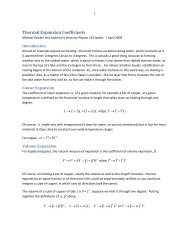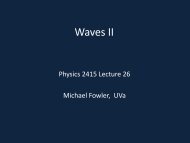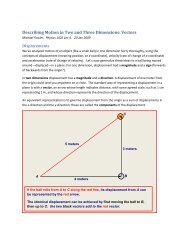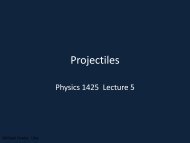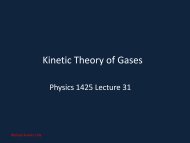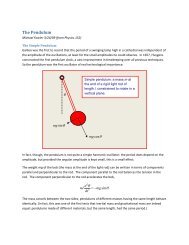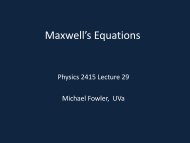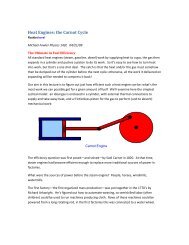Class Notes on Rotational Motion - Galileo and Einstein
Class Notes on Rotational Motion - Galileo and Einstein
Class Notes on Rotational Motion - Galileo and Einstein
Create successful ePaper yourself
Turn your PDF publications into a flip-book with our unique Google optimized e-Paper software.
6Torque around axlefrom small part ofan off-center wheelτ i = m i gx i .axlex im im i gAs discussed in the preceding secti<strong>on</strong>, the torque about the axle of the weight of the small mass m i isequal to m i g multiplied by the perpendicular distance from the axle to the line of acti<strong>on</strong> of the force,that is, m i gx i , taking the axle as the origin of coordinates.Evidently the magnitude of the total gravitati<strong>on</strong>al torque from the imbalancefrom the definiti<strong>on</strong> of the center of mass. im gxiiMgxKinds of EquilibriumIf there is no fricti<strong>on</strong> at the axle, the wheel can <strong>on</strong>ly be at rest if the center of mass lies <strong>on</strong> the verticalline through the axle. If the center of mass is directly above the axle, the wheel might be at rest, but theslightest push will start it turning: this is called “unstable equilibrium”. If the center of mass is below theaxle, a slight push to <strong>on</strong>e side will cause the wheel to swing back then oscillate, a topic we’ll return tolater—this is “stable equilibrium”. If the center of mass is exactly at the axle, the wheel will rotate at asteady rate—this is “neutral equilibrium”. These all have analogies in linear moti<strong>on</strong>: assuming nofricti<strong>on</strong>, unstable equilibrium is a ball perched <strong>on</strong> a mountaintop, stable is a ball sitting at the bottom ofa valley, <strong>and</strong> neutral is a ball <strong>on</strong> a flat plane. In two dimensi<strong>on</strong>s, there are more complicatedpossibilities: a ball in the middle of a saddle might be stable for displacements parallel to the horse, butunstable for displacement the other way. Situati<strong>on</strong>s analogous to this horsy example do in fact occur inphysical systems.Rotati<strong>on</strong>al Equivalent of Newt<strong>on</strong>’s Sec<strong>on</strong>d LawA Simple Example: Introducing the Moment of Inertia Newt<strong>on</strong>’s Sec<strong>on</strong>d Law, in the form F ma , states that an object undergoes linear accelerati<strong>on</strong> inresp<strong>on</strong>se to an net external force, <strong>and</strong> the mass determines the magnitude of this resp<strong>on</strong>se. It’s prettyCM




